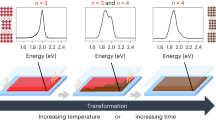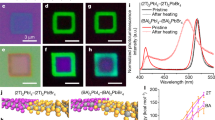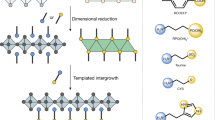Abstract
Ruddlesden–Popper lead halide perovskites have emerged as a new class of two-dimensional semiconductors with tunable optoelectronic properties, potentially offering unlimited heterostructure configurations for exploration. However, the practical realization of such heterostructures is challenging because of the difficulty in achieving controllable direct synthesis or van der Waals integration of halide perovskites due to their mobile and fragile crystal lattices. Here we report direct growth of large-area nanosheets of diverse phase-pure Ruddlesden–Popper perovskites with thicknesses down to one monolayer at the solution–air interface and a reliable approach for gently transferring and stacking these nanosheets. These advances enable the deterministic fabrication of arbitrary vertical heterostructures and multi-heterostructures of Ruddlesden–Popper perovskites with greater structural degrees of freedom that define the electronic structures of the heterojunctions. Such rationally designed heterostructures exhibit interesting interlayer properties, such as interlayer carrier transfer and reduction of the photoluminescence linewidth, and could enable the exploration of exciton physics and optoelectronic applications.
This is a preview of subscription content, access via your institution
Access options
Access Nature and 54 other Nature Portfolio journals
Get Nature+, our best-value online-access subscription
$29.99 / 30 days
cancel any time
Subscribe to this journal
Receive 12 print issues and online access
$259.00 per year
only $21.58 per issue
Buy this article
- Purchase on Springer Link
- Instant access to full article PDF
Prices may be subject to local taxes which are calculated during checkout




Similar content being viewed by others
Data availability
The data presented in the Supplementary Information that support the findings of this study are available from the corresponding authors upon reasonable request. Source data are provided with this paper.
References
Mao, L., Stoumpos, C. C. & Kanatzidis, M. G. Two-dimensional hybrid halide perovskites: principles and promises. J. Am. Chem. Soc. 141, 1171–1190 (2019).
Fu, Y. et al. Metal halide perovskite nanostructures for optoelectronic applications and the study of physical properties. Nat. Rev. Mater. 4, 169–188 (2019).
Stranks, S. D. & Snaith, H. J. Metal-halide perovskites for photovoltaic and light-emitting devices. Nat. Nanotechnol. 10, 391–402 (2015).
Katan, C., Mercier, N. & Even, J. Quantum and dielectric confinement effects in lower-dimensional hybrid perovskite semiconductors. Chem. Rev. 119, 3140–3192 (2019).
Charbonneau, S., Thewalt, M. L., Koteles, E. S. & Elman, B. Transformation of spatially direct to spatially indirect excitons in coupled double quantum wells. Phys. Rev. B 38, 6287–6290 (1988).
Golub, J. E., Kash, K., Harbison, J. P. & Florez, L. T. Long-lived spatially indirect excitons in coupled GaAs/AlxGa1-xAs quantum wells. Phys. Rev. B 41, 8564–8567 (1990).
Butov, L. V., Zrenner, A., Abstreiter, G., Bohm, G. & Weimann, G. Condensation of indirect excitons in coupled AlAs/GaAs quantum wells. Phys. Rev. Lett. 73, 304–307 (1994).
Butov, L. V. et al. Stimulated scattering of indirect excitons in coupled quantum wells: signature of a degenerate Bose-gas of excitons. Phys. Rev. Lett. 86, 5608–5611 (2001).
Blancon, J. C. et al. Scaling law for excitons in 2D perovskite quantum wells. Nat. Commun. 9, 2254 (2018).
Leng, K. et al. Molecularly thin two-dimensional hybrid perovskites with tunable optoelectronic properties due to reversible surface relaxation. Nat. Mater. 17, 908–914 (2018).
Wang, J. et al. Room temperature coherently coupled exciton-polaritons in two-dimensional organic-inorganic perovskite. ACS Nano 12, 8382–8389 (2018).
Dou, L. T. et al. Atomically thin two-dimensional organic-inorganic hybrid perovskites. Science 349, 1518–1521 (2015).
Gao, Y. et al. Molecular engineering of organic-inorganic hybrid perovskites quantum wells. Nat. Chem. 11, 1151–1157 (2019).
Novoselov, K. S., Mishchenko, A., Carvalho, A. & Castro Neto, A. H. 2D materials and van der Waals heterostructures. Science 353, aac9439 (2016).
Liu, Y., Huang, Y. & Duan, X. F. Van der Waals integration before and beyond two-dimensional materials. Nature 567, 323–333 (2019).
Rivera, P. et al. Interlayer valley excitons in heterobilayers of transition metal dichalcogenides. Nat. Nanotechnol. 13, 1004–1015 (2018).
Mak, K. F. & Shan, J. Opportunities and challenges of interlayer exciton control and manipulation. Nat. Nanotechnol. 13, 974–976 (2018).
Wang, J. et al. Controllable synthesis of two-dimensional Ruddlesden-Popper-type perovskite heterostructures. J. Phys. Chem. Lett. 8, 6211–6219 (2017).
Wang, J. et al. Controllable growth of centimeter-sized 2D perovskite heterostructures for highly narrow dual-band photodetectors. ACS Nano 13, 5473–5484 (2019).
Yuan, M. et al. Perovskite energy funnels for efficient light-emitting diodes. Nat. Nanotechnol. 11, 872–877 (2016).
Proppe, A. H. et al. Synthetic control over quantum well width distribution and carrier migration in low-dimensional perovskite photovoltaics. J. Am. Chem. Soc. 140, 2890–2896 (2018).
Wang, N. N. et al. Perovskite light-emitting diodes based on solution-processed self-organized multiple quantum wells. Nat. Photon. 10, 699–704 (2016).
Fu, Y. et al. Multicolor heterostructures of two-dimensional layered halide perovskites that show interlayer energy transfer. J. Am. Chem. Soc. 140, 15675–15683 (2018).
Zhu, H. et al. Lead halide perovskite nanowire lasers with low lasing thresholds and high quality factors. Nat. Mater. 14, 636–642 (2015).
Ma, D. et al. Single-crystal microplates of two-dimensional organic–inorganic lead halide layered perovskites for optoelectronics. Nano Res. 10, 2117–2129 (2017).
Pan, D. et al. Visualization and studies of ion-diffusion kinetics in cesium lead bromide perovskite nanowires. Nano Lett. 18, 1807–1813 (2018).
Lai, M. L. et al. Intrinsic anion diffusivity in lead halide perovskites is facilitated by a soft lattice. Proc. Natl Acad. Sci. USA 115, 11929–11934 (2018).
Shi, E. Z. et al. Two-dimensional halide perovskite lateral epitaxial heterostructures. Nature 580, 614–620 (2020).
Meng, F., Morin, S. A., Forticaux, A. & Jin, S. Screw dislocation driven growth of nanomaterials. Acc. Chem. Res. 46, 1616–1626 (2013).
Liang, D. et al. Color-pure violet-light-emitting diodes based on layered lead halide perovskite nanoplates. ACS Nano 10, 6897–6904 (2016).
Gong, X. W. et al. Electron-phonon interaction in efficient perovskite blue emitters. Nat. Mater. 17, 550–556 (2018).
Meitl, M. A. et al. Transfer printing by kinetic control of adhesion to an elastomeric stamp. Nat. Mater. 5, 33–38 (2005).
Blake, P. et al. Making graphene visible. Appl. Phys. Lett. 91, 063124 (2007).
Haigh, S. J. et al. Cross-sectional imaging of individual layers and buried interfaces of graphene-based heterostructures and superlattices. Nat. Mater. 11, 764–767 (2012).
Tu, Q. et al. Out-of-plane mechanical properties of 2D hybrid organic-inorganic perovskites by nanoindentation. ACS Appl. Mater. Interfaces 10, 22167–22173 (2018).
Lin, Y. et al. Suppressed ion migration in low-dimensional perovskites. ACS Energy Lett. 2, 1571–1572 (2017).
Mauck, C. M. & Tisdale, W. A. Excitons in 2D organic–inorganic halide perovskites. Trends Chem. 1, 380–393 (2019).
Zhang, S. et al. Synthesis and optical properties of novel organic–inorganic hybrid nanolayer structure semiconductors. Acta Mater. 57, 3301–3309 (2009).
Ni, L. M. et al. Real-time observation of exciton-phonon coupling dynamics in self-assembled hybrid perovskite quantum wells. ACS Nano 11, 10834–10843 (2017).
Fu, Y. et al. Incorporating large A cations into lead iodide perovskite cages: relaxed Goldschmidt tolerance factor and impact on exciton-phonon interaction. ACS Cent. Sci. 5, 1377–1386 (2019).
Herz, L. M. How lattice dynamics moderate the electronic properties of metal-halide perovskites. J. Phys. Chem. Lett. 9, 6853–6863 (2018).
Hautzinger, M. P. et al. Band edge tuning of two-dimensional Ruddlesden–Popper perovskites by A cation size revealed through nanoplates. ACS Energy Lett. 5, 1430–1437 (2020).
Spanopoulos, I. et al. Uniaxial expansion of the 2D Ruddlesden-Popper perovskite family for improved environmental stability. J. Am. Chem. Soc. 141, 5518–5534 (2019).
Zhao, Y. & Jin, S. Controllable water vapor assisted chemical vapor transport synthesis of WS2–MoS2 heterostructure. ACS Mater. Lett. 2, 42–48 (2019).
Chen, Y. et al. Robust interlayer coupling in two-dimensional perovskite/monolayer transition metal dichalcogenide heterostructures. ACS Nano 14, 10258–10264 (2020).
Roy, S. et al. Measurement of quantum yields of monolayer TMDs using dye-dispersed PMMA thin films. Nanomaterials 10, 1032 (2020).
Acknowledgements
This work is supported by the Department of Energy, Office of Basic Energy Sciences, Division of Materials Sciences and Engineering, under Award Number DE-FG02-09ER46664.
Author information
Authors and Affiliations
Contributions
S.J., Y.F. and D.P. conceived the research. D.P. and Y.F. designed and conducted the experiments and analysed the experimental results. N.S. and D.D.K. conducted PLE and TRPL measurements and analysed the results. Y.Z. designed and built the transfer stage. D.J.M. and J.C.W. performed PL line profile analysis and assisted with the analysis of various spectroscopic results. C.R.R. helped with PL mapping. S.J. and J.C.W. supervised the project. D.P., Y.F. and S.J. co-wrote the manuscript with input from all authors.
Corresponding authors
Ethics declarations
Competing interests
The authors declare no competing interests.
Additional information
Peer review information Nature Nanotechnology thanks Dehui Li, Biwu Ma and the other, anonymous, reviewer(s) for their contribution to the peer review of this work.
Publisher’s note Springer Nature remains neutral with regard to jurisdictional claims in published maps and institutional affiliations.
Supplementary information
Supplementary Information
Supplementary Figs. 1–22 and Table 1.
Supplementary Video 1
Supplementary Video 1 shows the growth of the nanosheets of (HA)2PbI4 in real time as they are floating on the precursor solution droplet. Layer-by-layer growth propagation across the whole sheets could be observed.
Supplementary Video 2
Supplementary Video 2 shows the growth of (HA)2(FA)Pb2I7. The video was recorded in real time in dark field with a 232 μm × 174 μm field of view. As the growth proceeded further, the thick spiral plate formed through dislocation-driven growth thickened, but the thin sheets next to it shrunk in size, in an Ostwald ripening process.
Source data
Source Data Fig. 1
Experimental data points of the PL spectra shown in Fig. 1c.
Source Data Fig. 2
Experimental data points of the extracted AFM height profiles shown in Fig. 2g–k.
Source Data Fig. 3
Experimental data points of the PL spectra shown in Fig. 3a(iv), b(iv) and c(iv).
Source Data Fig. 4
Experimental data points of the PL spectra shown in Fig. 4g.
Rights and permissions
About this article
Cite this article
Pan, D., Fu, Y., Spitha, N. et al. Deterministic fabrication of arbitrary vertical heterostructures of two-dimensional Ruddlesden–Popper halide perovskites. Nat. Nanotechnol. 16, 159–165 (2021). https://doi.org/10.1038/s41565-020-00802-2
Received:
Accepted:
Published:
Issue Date:
DOI: https://doi.org/10.1038/s41565-020-00802-2
This article is cited by
-
Universal growth of perovskite thin monocrystals from high solute flux for sensitive self-driven X-ray detection
Nature Communications (2024)
-
Two-dimensional lead halide perovskite lateral homojunctions enabled by phase pinning
Nature Communications (2024)
-
Growth of millimeter-sized 2D metal iodide crystals induced by ion-specific preference at water-air interfaces
Nature Communications (2024)
-
Materials design and preparation of ultrathin two-dimensional metal halide perovskites
Nano Research (2024)
-
Exciton dissociation in 2D layered metal-halide perovskites
Nature Communications (2023)



